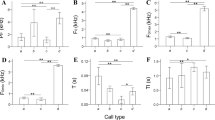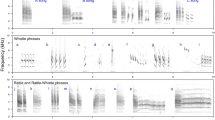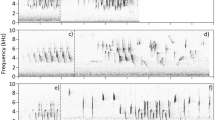Abstract
Soricids produce a considerable variety of vocalizations. However, these calls have been studied insufficiently with the exception of echolocation calls. In this study, 1,645 calls from 18 juvenile, ten sub-adult and 36 adult Asian house shrews (Suncus murinus) were acoustically and statistically analyzed to describe this species’ vocal repertoire and its ontogeny. The vocal repertoire of S. murinus includes 17 call types, seven tonal (whistle, chirp, twitter, whimper, squeak, scream and short scream) and ten non-tonal (churr, shriek, babble, click, boom, snort, screech, short screech, sniff and low click), of which ten call types (whimper, squeak, scream, short scream, churr, babble, snort, short screech, sniff and low click) were newly described by this study. This relatively extensive vocal repertoire, including one call type emitted during collective resting, indicates that this species possibly possesses a higher degree of sociality and cohesiveness than previously expected. High structural similarities were observed between calls produced by juveniles and sub-adults during caravanning and those produced by adult males during courtship. Therefore, the results of this study support a previously suggested hypothesis that in shrews, adult courtship calls are derived from calls emitted by the young. The results of this study also showed that the largest changes in the ontogeny of the vocal repertoire occurred at approximately 10 days old and was in close connection to the eyes opening. The results are discussed with available information on the vocal repertoires of other soricids.







Similar content being viewed by others
References
Attié C (1990) Emissions sonores chez le Hérisson européen, Erinaceus europaeus, et signification comportementale. Mammalia 54:3–12
August PV, Anderson JGT (1987) Mammal sounds and motivation—structural rules: a test of the hypothesis. J Mamm 68:1–9
Bajkowska U, Chętnicki W, Fedyk S (2009) Breeding of the common shrew, Sorex araneus, under laboratory conditions. Folia Zool 58:1–8
Baxter RM, Meester J (1980) Notes on the captive behaviour of five species of southern African shrews. Säugetierkundl Mitt 28:55–62
Benson BN, Binz H, Zimmermann E (1992) Vocalizations of infant and developing tree shrews (Tupaia belangeri). J Mamm 73:106–119
Blossom PM (1932) A pair of long-tailed shrews (Sorex cinereus cinereus) in captivity. J Mamm 13:136–143
Buchler ER (1976) The use of echolocation by the wandering shrew (Sorex vagrans). Anim Behav 24:858–873
Catania KC, Hare JF, Campbell KL (2008) Water shrews detect movement, shape, and smell to find prey underwater. PNAS 105:571–576
Conner DA, Whitworth MR (1985) The ontogeny of vocal communication in the pika. J Mamm 66:756–763
Dippenaar NJ (1979) Notes on the early post-natal development and behaviour of the tiny musk shrew, Crocidura bicolor Bocage, 1889 (Insectivora: Soricidae). Mammalia 43:83–91
Dryden GL (1968) Growth and development of Suncus murinus in captivity on Guam. J Mamm 49:51–62
Ehret G (1980) Development of sound communication in mammals. Adv Stud Behav 11:179–225
Ehrlich C (2006) Kleinsäuger im Terrarium – Biologie, Haltung, Zucht. 2. überarbeitete Aufgabe. Natur und Tier-Verlag GmbH, Münster
Eibl-Eibesfeldt I (1951) Beobachtungen zur Fortpflanzungsbiologie und Jugendentwicklung des Eichhörnchens (Sciurus vulgaris). Z Tierpsychol 8:370–400
Eisenberg JF, Gould E (1970) The tenrecs: a study in mammalian behavior and evolution. Smithsonian Contrib Zool 27:1–138
Fons R (1974) Le repertoire comportemental de la pachyure etrusque, Suncus etruscus (Savi, 1822). La Terre et la Vie 1:131–157
Forsman KA, Malmquist MG (1988) Evidence for echolocation in the common shrew, Sorex araneus. J Zool Lond 216:655–662
Frank F (1953) Beitrag zur Biologie, insbesondere Paarungsbiologie der Feldspitzmaus (Crocidura leucodon). Bonn Zool Beitr 4:187–194
Gogoleva SS, Volodin IA, Volodina EV, Kharlamova AV (2009) Kind granddaughters of angry grandmothers: the effect of domestication on vocalization in cross-bred silver foxes. Behav Process 81:369–375
Gould E (1969) Communication in three genera of shrews (Soricidae): Suncus, Blarina and Cryptotis. Comm Behav Biol Part A 3:11–31
Gould E (1979) Neonatal vocalizations of ten species of Malaysian bats (Megachiroptera and Microchiroptera). Am Zool 19:481–491
Gould E, Negus NC, Novick A (1964) Evidence for echolocation in shrews. J Exp Zool 156:19–38
Grünwald A, Möhres FP (1974) Beobachtungen zur Jugendentwicklung und Karawanenbildung bei Weisszahnspitzmäusen (Soricidae–Crocidurinae). Z Säugetierk 39:321–337
Hafner MS, Hafner DJ (1979) Vocalizations of grasshopper mice (genus Onychomys). J Mamm 60:85–94
Hamilton WJ Jr (1929) Breeding habits of the short-tailed shrew, Blarina brevicauda. J Mamm 10:125–134
Hanzák J (1966) Vývoj mláďat bělozubky šedé, Crocidura suaveolens (Pallas) 1821. Lynx 6:67–74
Hart FM, King JA (1966) Distress vocalizations of young in two subspecies of Peromyscus maniculatus. J Mamm 47:287–293
Hashimoto H, Moritani N, Saito TR (2004) Copulatory behavior and fertility of male house musk shrews (Suncus murinus) paired with one, two and four females each. Exp Anim 53:53–56
Hellwing S (1973) The postnatal development of the white-toothed shrew Crocidura russula monacha in captivity. Z Säugetierk 38:257–270
Hutterer R (1976) Beobachtungen zur Geburt und Jugendentwicklung der Zwergspitzmaus, Sorex minutus L. (Soricidae – Insectivora). Z Säugetierk 41:1–22
Hutterer R (1978) Paarungsrufe der Wasserspitzmaus (Neomys fodiens) und verwandte Laute weiterer Soricidae. Z Säugetierk 43:330–336
Hutterer R (1982) Biologische und morphologische Beobachtungen an Alpenspitzmäusen (Sorex alpinus). Bonn Zool Beitr 33:3–18
Hutterer R, Molur S, Heaney L (2008) Suncus murinus. In: IUCN 2011. IUCN red list of threatened species. Version 2011.2. www.iucnredlist.org. Downloaded on 31 March 2012
Hutterer R, Vogel P (1977) Abwehrlaute afrikanischer Spitzmäuse der Gattung Crocidura Wagler, 1832 und ihre systematische Bedeutung. Bonn Zool Beitr 28:218–227
Hutterer R, Vogel P, Frey H, Genoud M (1979) Vocalization of the shrews Suncus etruscus and Crocidura russula during normothermia and torpor. Acta Theriol 24:267–271
Klecka WR (1980) Discriminant analysis. Sage University Papers Series on Quantitative Applications in the Social Sciences. Newbury Park, CA: Sage
Köhler D (1998) Zur Lautgebung einiger paläarktischer Soriciden: Analyse von Abwehr- und Positionrufen. BUB 3:91–98
Köhler D, Wallschläger D (1987) On vocalization of the European water shrew, Neomys fodiens (Insectivora: Soricidae). Zool Jb Physiol 91:89–99 [in German]
Konstantinov AI, Movchan VN (1985) Sounds in the life of animals. Isdatelstvo Leningradskogo Universiteta, Leningrad [in Russian]
Lishak RS (1982) Vocalizations of nestling gray squirrels. J Mamm 63:446–452
Long CV (2007) Vocalizations of the degu Octodon degus, a social caviomorph rodent. Bioacoustics 16:223–244
Long JL (2003) Introduced mammals of the world: their history, distribution and influence. CSIRO Publishing, Melbourne
Mandelli MJ, Sales G (2004) Ultrasonic vocalizations of infant short-tailed field voles, Microtus agrestis. J Mamm 85:282–289
Matsuzaki O (2002) The force driving mating behavior in the house musk shrew (Suncus murinus). Zool Sci 19:851–869
Matsuzaki O (2004) Inter-male mating-like behavior in the domesticated house musk shrew, Suncus murinus. Zool Sci 21:43–51
Michalak I (1987) Growth and postnatal development of the European water shrew. Acta Theriol 32:261–288
Mitchell BR, Makagon MM, Jaeger MM, Barrett RH (2006) Information content of coyote barks and howls. Bioacoustics 15:289–314
Monticelli PF, Ades C (2011) Bioacoustics of domestication: alarm and courtship calls of wild and domestic cavies. Bioacoustics 20:169–192
Morton ES (1977) On the occurrence and significance of motivation—structural rules in some bird and mammal sounds. Am Nat 111:855–869
Movchan VN, Shibkov AA (1982) Structural patterns of acoustic signals in shrews (Soricidae). Zool Zh 61:1695–1705 [in Russian]
Nowak RM (1999) Walker’s mammals of the world, 6th edn. Johns Hopkins Univ, Press, Baltimore, MD
Olsen RW (1969) Agonistic behavior of the short-tailed shrew (Blarina brevicauda). J Mamm 50:494–500
Romesburg HC (1984) Cluster analysis for researchers. Lifetime Learning Publications, Belmont, CA
Rood JP (1958) Habits of the short-tailed shrew in captivity. J Mamm 39:499–507
Shibkov AA, Movchan VN, Sobolevskii SA (2001) Acoustic signalling of the water shrew, Neomys fodiens (Insectivora, Soricidae), in conflict interruptions. Zool Zh 80:454–458 [in Russian]
Siemers BM, Schauermann G, Turni H, von Merten S (2009) Why do shrews twitter? Communication or simple echo-based orientation. Biol Lett 5:593–596
Simeonovska-Nikolova DM (2004) Vocal communication in the bicoloured white-toothed shrew Crocidura leucodon. Acta Theriol 49:157–165
Skarén U (1979) Mating behaviour of Sorex isodon Turov. Ann Zool Fenn 16:291–293
Sorenson MW (1962) Some aspects of water shrew behavior. Am Midl Nat 68:445–462
Stine CJ, Dryden GL (1977) Lip-licking behavior in captive musk shrews, Suncus murinus. Behaviour 62:298–313
Temple JL (2004) The musk shrew (Suncus murinus): a model species for studies of nutritional regulation of reproduction. ILAR J 45:25–34
Thomas JA, Jalili MS (2004) Review of echolocation in insectivores and rodents. In: Thomas JA, Moss CF, Vater M (eds) Echolocation in bats and dolphins. University of Chicago Press, Chicago, IL
Tomasi TE (1979) Echolocation by the short-tailed shrew Blarina brevicauda. J Mamm 60:751–759
Tsuji K, Ishikawa T (1984) Some observations of the caravanning behavior in the musk shrew (Suncus murinus). Behaviour 90:167–183
Tsuji K, Ishii K, Matsuo T, Kawano K (1999) The house musk shrew Suncus murinus as a new laboratory animal for use in behavioural studies. Jpn J Animal Psychol 49:1–18
Vlasák P (1970) The biology of reproduction and post-natal development of Crocidura suaveolens Pallas, 1811 under laboratory conditions. Acta Univ Carol Biol 3:207–292
Vogel P (1970) Biologische Beobachtungen an Estruskerspitzmäusen (Suncus etruscus Savi, 1832). Z Säugetierk 35:173–185
Vogel P (1972) Beitrag zur Fortpflanzungsbiologie der Gattungen Sorex, Neomys und Crocidura (Soricidae). Verhandl Naturforsch Gesellsch Basel 82:165–192
Volodin IA, Zaytseva AS, Ilchenko OG, Volodina EV, Chebotareva AL (2012) Measuring airbone components of seismic body vibrations in a Middle-Asian send-dwelling Insectivora species, the piebald shrew (Diplomesodon pulchellum). J Exp Biol 215:2849–2852
Zimmermann E (1985) The vocal repertoire of the adult Senegal bushbaby (Galago senegalensis senegalensis). Behaviour 94:212–233
Zippelius HM (1972) Die Karawanenbildung bei Feld- und Hausspitzmaus. Z Tierpsychol 30:305–320
Acknowledgments
I thank Michaela Procházková and Jan Procházka for allowing me to work with their shrews. I am also grateful to Vladimír Vohralík, Ilya Volodin, Elena Volodina and Vera Matrosova for their help with the literature and to the three anonymous referees for their comments on an earlier version of the manuscript. During the study, I followed the “Guidelines for the treatment of animals in behavioural research and teaching” (Anim. Behav. 71: 245–253) and the laws of the Czech Republic, the country where the research was conducted. The research was partially supported by the Foundation “Nadání Josefa, Marie a Zdeňky Hlávkových”.
Author information
Authors and Affiliations
Corresponding author
Additional information
Communicated by: Karol Zub
Electronic supplementary material
Rights and permissions
About this article
Cite this article
Schneiderová, I. Vocal repertoire ontogeny of the captive Asian house shrew Suncus murinus suggests that the male courtship call develops from the caravanning call of the young. Acta Theriol 59, 149–164 (2014). https://doi.org/10.1007/s13364-013-0141-1
Received:
Accepted:
Published:
Issue Date:
DOI: https://doi.org/10.1007/s13364-013-0141-1




